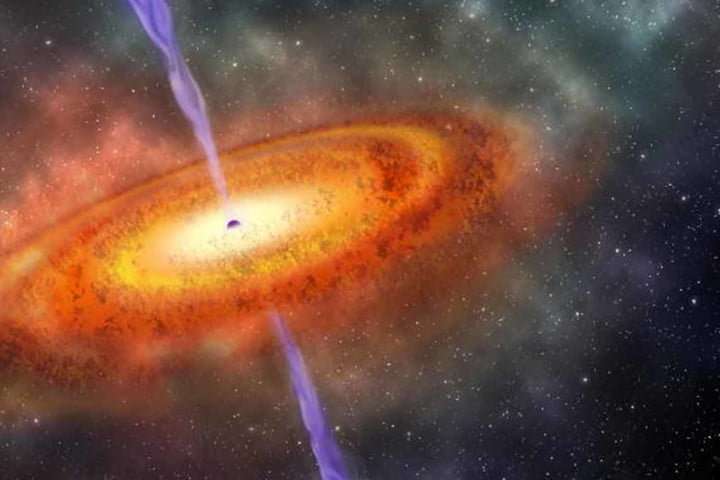March 12, 2018 report
Astronomers discover two bright high-redshift quasars

Using VST ATLAS and WISE surveys astronomers have identified two new bright high-redshift quasars. The newly found quasi-stellar objects, designated VST-ATLAS J158.6938-14.4211 and VST-ATLAS J332.8017-32.1036, could be helpful in improving our understanding of the evolution of the universe. The finding is reported March 4 in a paper published on arXiv.org.
Quasars with high redshift (over 6.0) are of special interest for astronomers because their ultraviolet light is absorbed by the neutral hydrogen along the line of sight; thus, they can be used to probe the intergalactic medium in the early universe. They are the most luminous and most distant, compact objects in the observable universe.
The spectrum of high-redshift quasars can be used to estimate the mass of a supermassive black hole, which constrains the evolution and formation model of a quasar. Therefore, such objects could serve as powerful tools to probe the early universe.
However, high-redshift quasars are very difficult to find using conventional color selections. This is due to their low spatial density and high contaminants from cool dwarfs. Among more than 300,000 quasars discovered to date, only 290 of them are at redshift higher than 5.0.
Now, a team of astronomers led by Ben Chehade of the Durham University, UK, has found two new high-redshift quasars by using the combination of the new Very Large Telescope Survey Telescope ATLAS (VST ATLAS) and Wide-field Infrared Survey Explorer (WISE). The detection was confirmed by follow-up spectroscopic observations utilizing the Low Resolution Imaging Spectrometer on the Keck I telescope and the European Southern Observatory's Faint Object Spectrograph and Camera 2 (EFOSC2) on the 3.58m ESO New Technology Telescope (NTT).
"Here we report on our continued search for 5.7 < z < 6.4 quasars over an ≈ 2× larger area of ≈ 3577 deg2 of the Southern Hemisphere. We have found two further z > 6 quasars, VST-ATLAS J158.6938-14.4211 at z = 6.07 and J332.8017-32.1036 at z = 6.32," the researchers wrote in the paper.
As noted in the study, VST-ATLAS J158.6938-14.4211 (J158-14 for short) has a redshift of 6.07, while VST-ATLAS J332.8017-32.1036 (J332-32 for short) was found at a redshift of 6.32. J158-14 and J332-32 have magnitudes of 19.4 and 19.7 respectively.
Moreover, the researchers have conducted a preliminary estimate of the black hole masses powering the two quasars. According to the paper, J158-14 has a black hole with a mass of about 1.8 billion solar masses and when it comes to J332-32, its black hole is approximately two billion times more massive than the sun.
The astronomers noted that a more detailed analysis of black hole masses of the two quasars will be published in another research paper. However, the currently available preliminary data, combined with previous studies, allowed Chehade's team to conclude that quasars identified by ATLAS survey are close to having some of the most massive black holes so far discovered.
More information: Two more, bright, z > 6 quasars from VST ATLAS and WISE, arXiv:1803.01424 [astro-ph.GA] arxiv.org/abs/1803.01424
Abstract
Recently, Carnall et al. discovered two bright high redshift quasars using the combination of the VST ATLAS and WISE surveys. The technique involved using the 3-D colour plane i-z:z-W1:W1-W2 with the WISE W1 (3.4 micron) and W2 (4.5 micron) bands taking the place of the usual NIR J band to help decrease stellar dwarf contamination. Here we report on our continued search for 5.76 quasars, VST-ATLAS J158.6938-14.4211 at z=6.07 and J332.8017-32.1036 at z=6.32 with magnitudes of z_AB=19.4 and 19.7 mag respectively. J158.6938-14.4211 was confirmed by Keck LRIS observations and J332.8017-32.1036 was confirmed by ESO NTT EFOSC-2 observations. Here we present VLT X-shooter Visible and NIR spectra for the four ATLAS quasars. We have further independently rediscovered two z>5.7 quasars previously found by the VIKING/KiDS and PanSTARRS surveys. This means that in ATLAS we have now discovered a total of six quasars in our target 5.7
© 2018 Phys.org




















